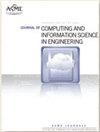机器人机构的深度学习驱动设计
IF 3.3
3区 工程技术
Q2 COMPUTER SCIENCE, INTERDISCIPLINARY APPLICATIONS
Journal of Computing and Information Science in Engineering
Pub Date : 2023-05-18
DOI:10.1115/1.4062542
引用次数: 0
摘要
在本文中,我们讨论了深度神经网络(dnn)与机器人机构设计的最新进展的收敛性,这需要将设计问题概念化为从设计规范空间到机构空间参数化的学习问题。我们确定了三个关键的相互关联的问题,这些问题处于使用深度神经网络的多功能性来解决机制设计问题的前沿。第一个问题是机制的表示及其设计规范,其中表示挑战主要来自数据的非欧几里得性质。第二个问题是开发从设计规范空间到机构的映射,理想情况下,我们希望综合机构的类型和尺寸,以适应各种设计规范,包括路径综合,运动综合,枢轴位置约束等。第三个问题是为给定的设计规范设计端到端训练和生成多个候选机制的神经网络体系结构。我们还简要概述了这些问题的最新进展,并确定了研究界可能感兴趣的问题。本文章由计算机程序翻译,如有差异,请以英文原文为准。
Deep Learning-Driven Design of Robot Mechanisms
In this paper we discuss the convergence of recent advances in deep neural networks (DNNs) with design of robotic mechanisms, which entails the conceptualization of the design problem as a learning problem from the space of design specifications to a parameterization of the space of mechanisms. We identify three key inter-related problems that are at the forefront of using the versatility of DNNs in solving mechanism design problems. The first problem is that of representation of mechanisms and their design specifications, where the representation challenges arise primarily from the non-Euclidean nature of the data. The second problem is that of developing the mapping from the space of design specifications to the mechanisms where, ideally, we would like to synthesize both type and dimensions of the mechanism for a wide variety of design specifications including path synthesis, motion synthesis, constraints on pivot locations, etc. The third problem is that of designing the neural network architecture for end-to-end training and generation of multiple candidate mechanisms for a given design specification. We also present a brief overview of the state-of-the-art on each of these problems and identify questions of potential interest to the research community.
求助全文
通过发布文献求助,成功后即可免费获取论文全文。
去求助
来源期刊
CiteScore
6.30
自引率
12.90%
发文量
100
审稿时长
6 months
期刊介绍:
The ASME Journal of Computing and Information Science in Engineering (JCISE) publishes articles related to Algorithms, Computational Methods, Computing Infrastructure, Computer-Interpretable Representations, Human-Computer Interfaces, Information Science, and/or System Architectures that aim to improve some aspect of product and system lifecycle (e.g., design, manufacturing, operation, maintenance, disposal, recycling etc.). Applications considered in JCISE manuscripts should be relevant to the mechanical engineering discipline. Papers can be focused on fundamental research leading to new methods, or adaptation of existing methods for new applications.
Scope: Advanced Computing Infrastructure; Artificial Intelligence; Big Data and Analytics; Collaborative Design; Computer Aided Design; Computer Aided Engineering; Computer Aided Manufacturing; Computational Foundations for Additive Manufacturing; Computational Foundations for Engineering Optimization; Computational Geometry; Computational Metrology; Computational Synthesis; Conceptual Design; Cybermanufacturing; Cyber Physical Security for Factories; Cyber Physical System Design and Operation; Data-Driven Engineering Applications; Engineering Informatics; Geometric Reasoning; GPU Computing for Design and Manufacturing; Human Computer Interfaces/Interactions; Industrial Internet of Things; Knowledge Engineering; Information Management; Inverse Methods for Engineering Applications; Machine Learning for Engineering Applications; Manufacturing Planning; Manufacturing Automation; Model-based Systems Engineering; Multiphysics Modeling and Simulation; Multiscale Modeling and Simulation; Multidisciplinary Optimization; Physics-Based Simulations; Process Modeling for Engineering Applications; Qualification, Verification and Validation of Computational Models; Symbolic Computing for Engineering Applications; Tolerance Modeling; Topology and Shape Optimization; Virtual and Augmented Reality Environments; Virtual Prototyping

 求助内容:
求助内容: 应助结果提醒方式:
应助结果提醒方式:


